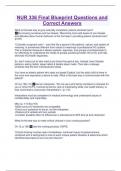NUR 336 Final Blueprint Questions and
Correct Answers
What is the best way to give culturally competent, patient-centered care?
✅By knowing ourselves and our biases. "Becoming more self-aware of your biases
and attitudes about human behavior is the first step in providing patient-centered care"
(p105)
*Culturally congruent care* - care that fits a person's life patterns, values, and system of
meaning. Is sometimes different from values & meanings of professional HC system.
This is important because it allows systems, agencies, and groups of professionals to
fxn effectively to understand the needs of groups accessing health info & HC and help
eliminate HC/health disparities.
Ex: don't instruct pt to take med at set times throughout day. Instead, learn lifestyle
patterns, eating habits, sleep habits & beliefs about meds. Then plan a dosage
schedule that fits their individualized needs.
You have an elderly patient who does not speak English, but the adult child is there in
the room and expresses a desire to help. What is the best way to communicate with this
patient?
Ch 9 p 108-110 ✅Get an interpreter. "Do not use a pt's family members to interpret for
you or other HCP's. Cultural dynamics, lack of interpreting skills, low health literacy, &
bias could lead to inaccurate interpretation". (p 110)
Interpreters must be competent in medical terminology and understand issues of
confidentiality and impartiality.
Misc (p. 110 Box 9-6)
-Make sure pt & interpreter are compatible.
-Direct your questions to the pt, not the interpreter.
-Observe pt's verbals and non-verbals
-Consider possible effect of differences in educational & SES bt/w pt and interpreter
What is the best way to make critical choices in your nursing practice?
Ch 15, p 196 ✅Use the nursing process, ADPIE.
"Critical thinking involves open-mindedness, continual inquiry & perserverence,
combined with a willingness to look at each unique patient situation & determine which
identified assumptions are true and relevant."
, "Recognize that a problem exists --> analyze info about problem (e.g., clinical data,
observation of pt behavior), --> evaluates info (e.g., reviewing assumptions and
evidence), --> makes conclusions so he or she can act appropriately."
Reflect on past experiences to help you make better judgments and enhances ability to
problem solve.
Compare assessment findings with baseline for this pt, and also what you have
observed with other patients
What is important to know about pain? How can you gather information about one's
pain?
Ch 44 p 1017 ✅Pain is subjective; it is what the patient tells you it is. As RN, you
cannot compare the pain of 1 pt to another.
Collect verbal and non-verbal cues. Patient may make incongruent statements in pain
rating compared to physical cues. This can give you insight as the RN, but cannot
adjust how to treat the pt's pain.
Non-verbals for acute pain: clenching teeth, facial grimacing, holding or guarding the
painful part, bent posture. Important in case pt cannot report verbally report pain
Chronic pain affects a patient's activity (eating, sleeping, socialization), thinking
(confusion, forgetfulness), or emotions (anger, depression, irritability) and quality of life
and productivity.
Remember that acute pain seriously threatens a patient's recovery by hampering his or
her ability to become active & involved in self care --> longer hospitalization from
complications (e.g., physical, emotional exhaustion, immobility, sleep deprivation,
pulmonary complications)
Planning pain care
Ch 44, p 1022, 1028-1029 ✅Always make a good plan with the patient to plan how
they want to manage their pain.
E.g., ask the patient if they want you to wake them up in the middle of the night to
administer pain meds, or if RN should let them sleep
-ask pt about their pain tolerance & previous pain experiences
-determine health literacy
-streamline assessment with acute pain
-PCTs can screen for pain, should inform RN and then RN can address
-Analyze info from multiple sources
-helping pts learn how to manage their pain




